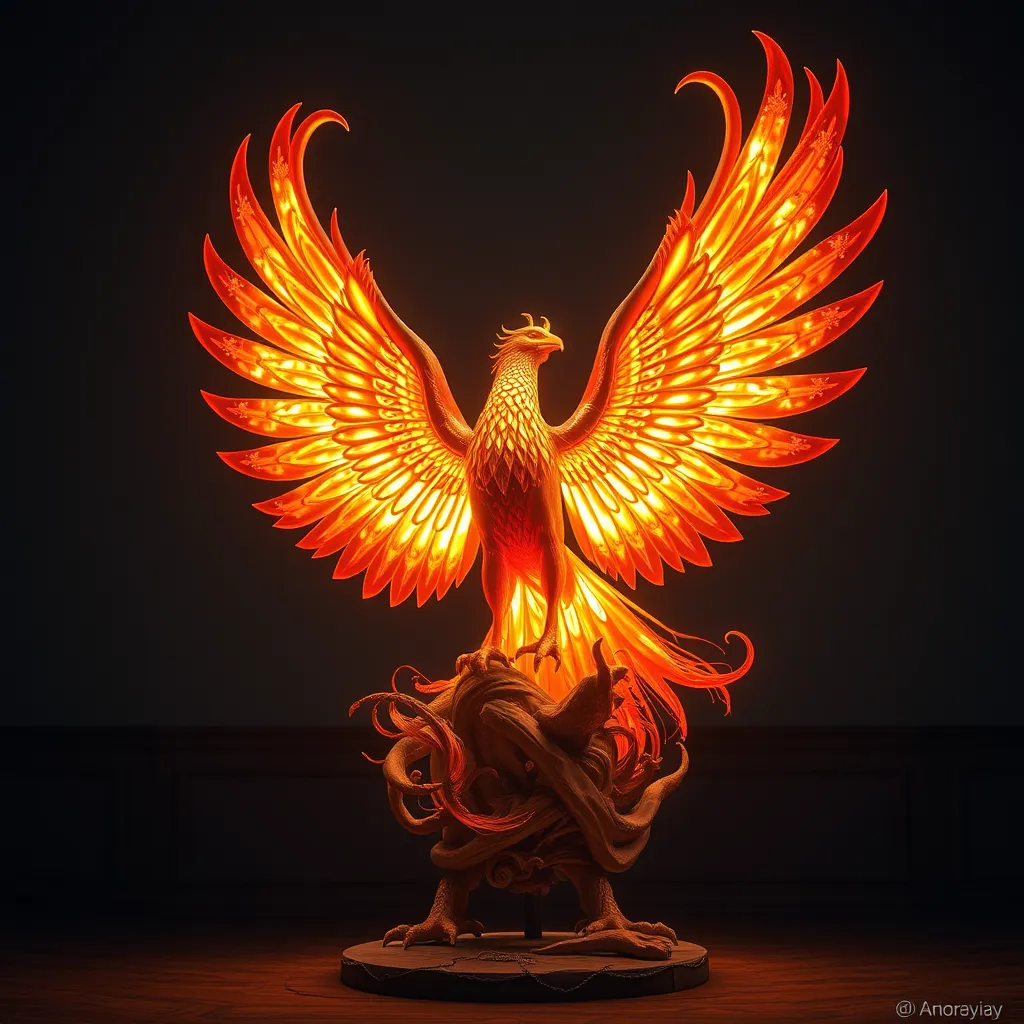The Phoenix in Art: From Ancient Sculptures to Modern Installations
I. Introduction
The Phoenix is a mythical bird that has captured the imagination of cultures around the world. In mythology, the Phoenix is often described as a magnificent bird that cyclically regenerates or is otherwise born again. This creature symbolizes rebirth, transformation, and the eternal nature of life. The purpose of this article is to explore the representation of the Phoenix in art through the ages, highlighting its evolution and significance in various cultural contexts.
II. Historical Significance of the Phoenix
The origins of the Phoenix myth can be traced back to ancient civilizations, with its roots found in Egyptian, Greek, and Roman mythologies.
- The Egyptian mythology portrays the Phoenix as the Bennu bird, associated with the sun and creation.
- In Greek mythology, the Phoenix is linked to the sun god, symbolizing the cycle of life and death.
- The Roman adaptation of the myth continued to emphasize themes of resurrection and renewal.
The Phoenix played a significant role in various cultural narratives, often serving as a metaphor for the human experience of overcoming adversity. Its influence on early artistic expressions is notable, as it inspired countless artworks that depict themes of rebirth and resilience.
III. The Phoenix in Ancient Sculptures
Notable examples of Phoenix representations can be found in ancient art, showcasing the bird’s significance across different cultures.
A. Notable examples of Phoenix representations in ancient art
- Egyptian reliefs and tomb artifacts: The Phoenix appears in various Egyptian tombs, symbolizing the soul’s immortality and the afterlife.
- Greek pottery and mosaics: The imagery of the Phoenix can be found on pottery, often depicted rising from its ashes, symbolizing hope and renewal.
B. Techniques and materials used in ancient sculptures
Ancient artists employed various techniques and materials to create representations of the Phoenix. For example, Egyptian artisans used stone relief techniques, while Greek artists often painted on clay vessels. These methods allowed for intricate details that highlighted the majestic nature of the Phoenix.
C. Interpretation of the Phoenix’s symbolism in these works
The symbolism of the Phoenix in ancient sculptures often conveyed messages of immortality, regeneration, and the cyclical nature of life. Artworks served not only as decorative elements but also as profound statements about existence and the human condition.
IV. The Phoenix in Medieval Art
During the medieval period, the Phoenix took on new meanings, particularly within Christian contexts.
A. The Phoenix as a Christian symbol of resurrection
In Christianity, the Phoenix became a symbol of Christ’s resurrection, representing eternal life and hope. Its ability to rise from the ashes mirrored the resurrection narrative, making it a powerful emblem in religious art.
B. Artistic representations in illuminated manuscripts and stained glass
The Phoenix was frequently depicted in illuminated manuscripts and stained glass windows, where it served as a reminder of spiritual renewal. These artworks often featured rich colors and intricate designs, emphasizing the bird’s beauty and significance.
C. Cultural exchanges and the evolution of the Phoenix motif
The medieval period saw cultural exchanges that transformed the representation of the Phoenix. As the motif spread across Europe, it adapted to various artistic styles and religious interpretations, demonstrating its versatility as a symbol.
V. The Phoenix During the Renaissance and Baroque Periods
The Renaissance and Baroque periods marked a revival of classical themes, leading to a reimagining of the Phoenix in art.
A. Revival of classical themes and the reimagining of the Phoenix
Artists drew inspiration from ancient mythologies, reinterpreting the Phoenix within the context of humanism and divine beauty.
B. Prominent artists and their interpretations of the Phoenix
Notable artists such as Albrecht Dürer and Peter Paul Rubens incorporated the Phoenix into their works, often portraying it in dynamic poses that emphasized its vitality and strength.
C. Impact of the Phoenix on literature and visual arts during this era
The Phoenix’s symbolism of rebirth resonated with the themes of transformation prevalent in Renaissance literature and visual arts, reinforcing its status as a powerful cultural icon.
VI. The Phoenix in 19th and 20th Century Art Movements
The symbolism of the Phoenix continued to evolve in the 19th and 20th centuries, reflecting the changing artistic landscape.
A. Symbolism of the Phoenix in Romanticism and Symbolism
In the Romantic movement, the Phoenix represented individual resilience in the face of societal challenges, often depicted in dramatic, emotive compositions.
B. The Phoenix in Surrealism and Modernism
Surrealist artists utilized the Phoenix to explore themes of dreams and the subconscious, portraying it in fantastical and often bizarre contexts that challenged traditional perceptions of reality.
C. Case studies: key artworks featuring the Phoenix during this period
- Gustave Moreau’s “The Phoenix”: This painting vividly illustrates the mythical bird amidst a dreamlike landscape, embodying the essence of transformation.
- Max Ernst’s “The Phoenix”: A surreal interpretation that captures the enigmatic nature of the Phoenix through unconventional forms and colors.
VII. Contemporary Representations of the Phoenix
In modern art, the Phoenix is often depicted in innovative ways, reflecting contemporary societal themes.
A. The Phoenix in modern installations and performance art
Contemporary artists have embraced the Phoenix in installations and performance art, using the motif to explore themes of resilience and regeneration in a rapidly changing world.
B. Use of technology and mixed media in contemporary interpretations
The integration of technology and mixed media has allowed artists to create immersive experiences that engage audiences on multiple levels, providing new interpretations of the Phoenix narrative.
C. The Phoenix as a symbol of resilience in today’s socio-political context
In today’s socio-political climate, the Phoenix serves as a powerful symbol of hope and resilience, representing the ability to rise from adversity and embrace change.
VIII. Conclusion
Throughout history, the Phoenix has journeyed through various artistic expressions, evolving from ancient sculptures to contemporary installations. Its enduring legacy as a symbol of rebirth and transformation resonates across cultures and time periods. The Phoenix remains a potent emblem of hope and renewal, reminding us of the resilience inherent in the human spirit. As we continue to navigate the complexities of modern life, the symbolism of the Phoenix inspires us to embrace change and rise anew from the challenges we face.



